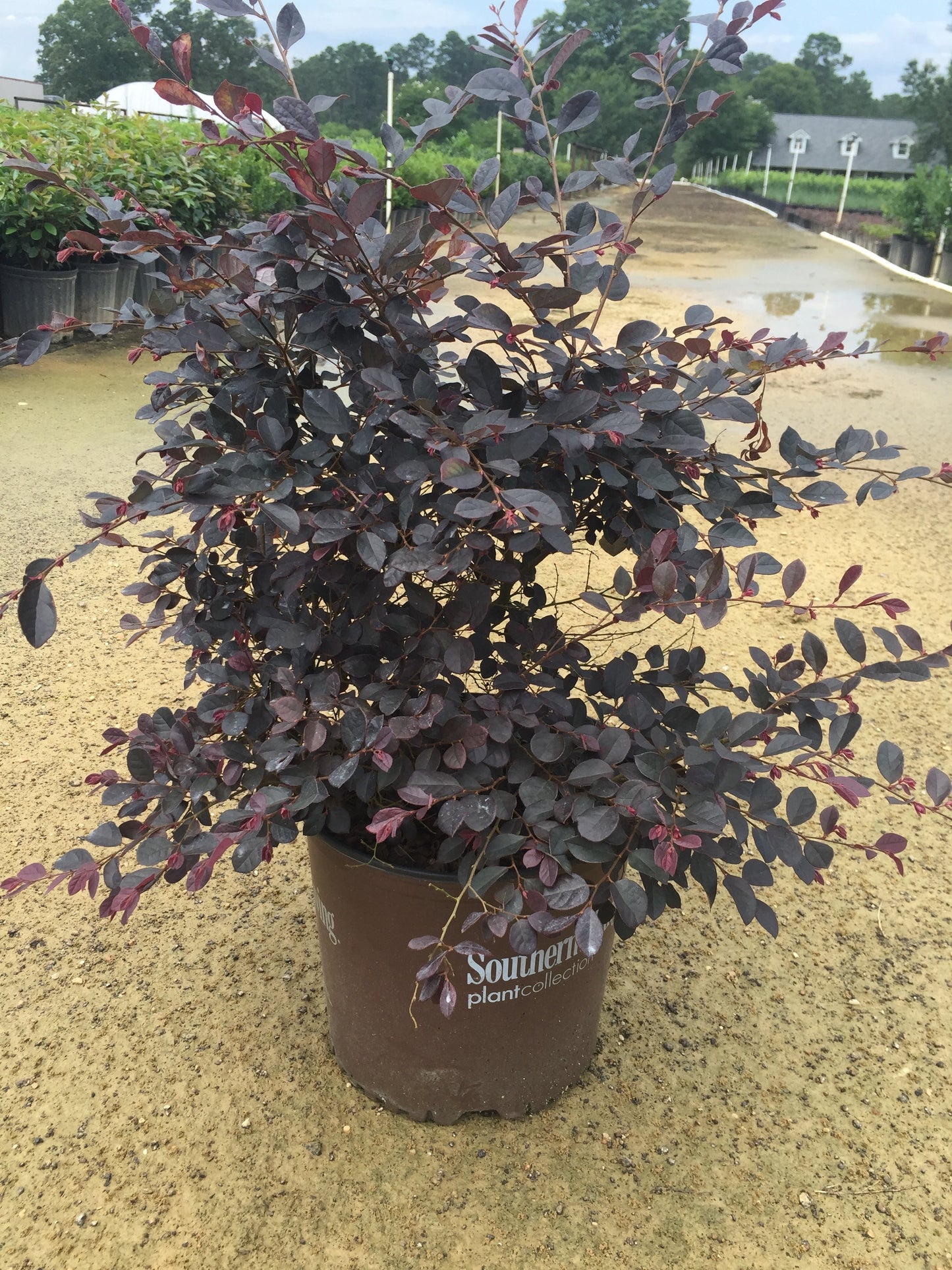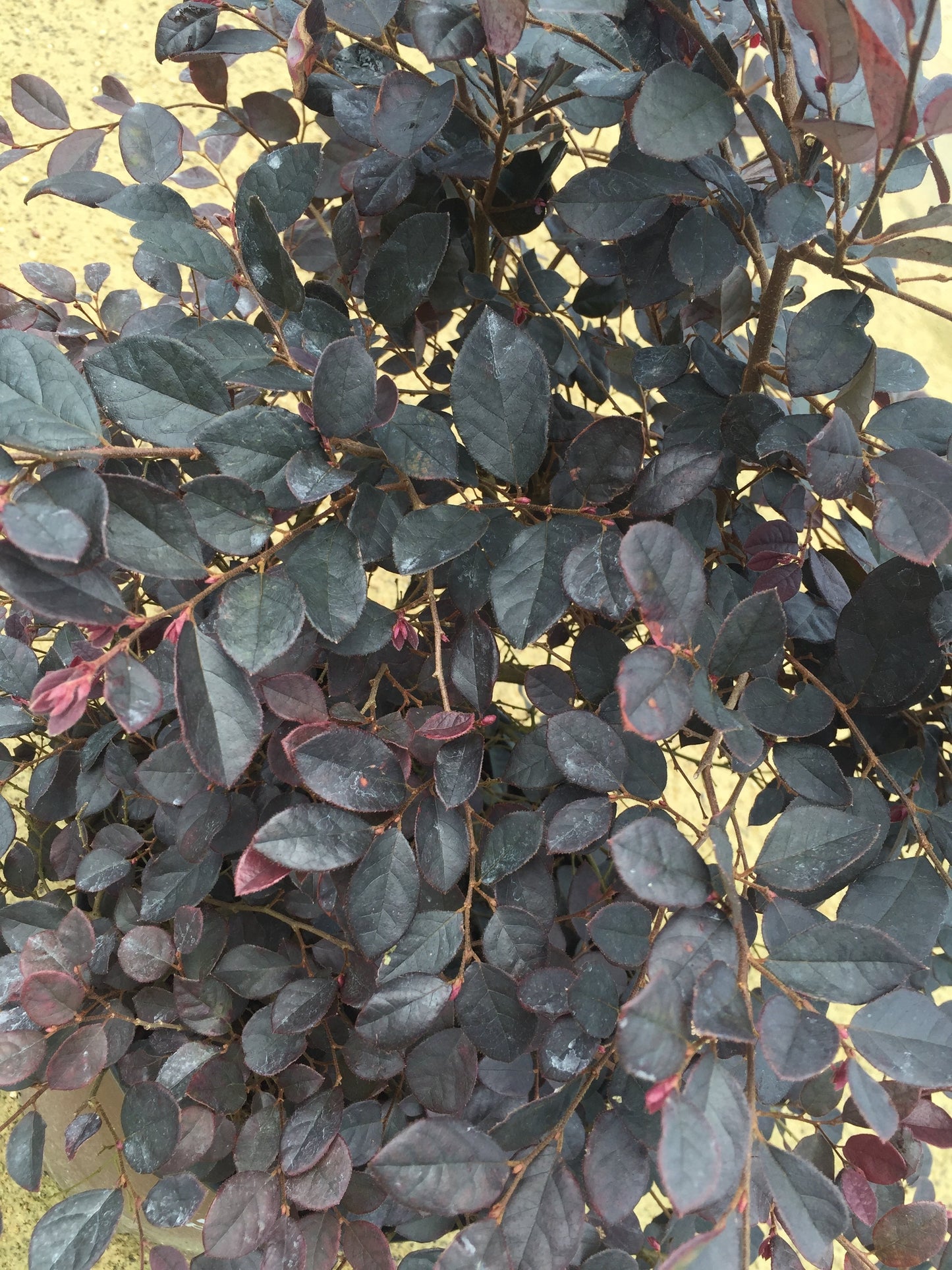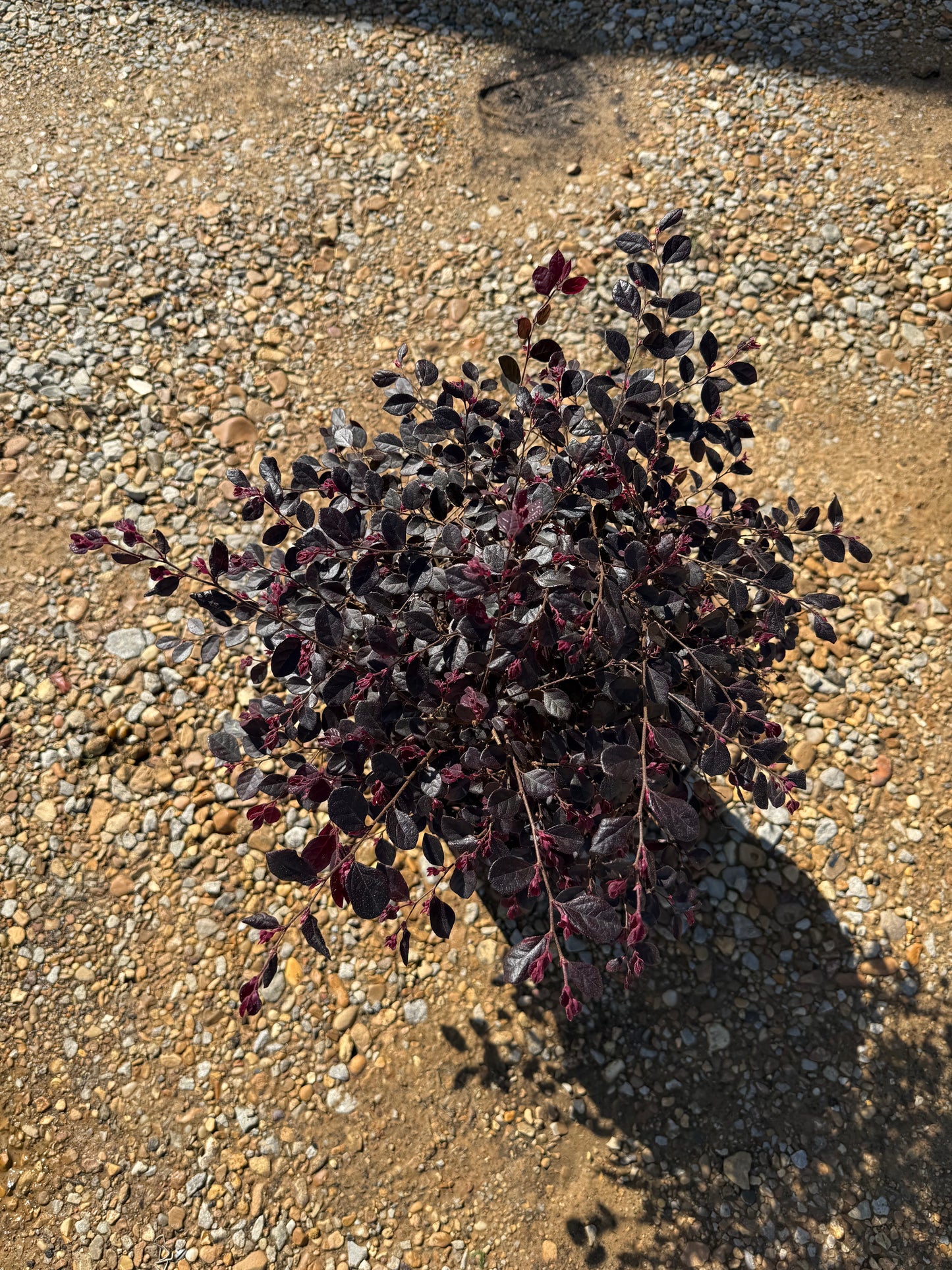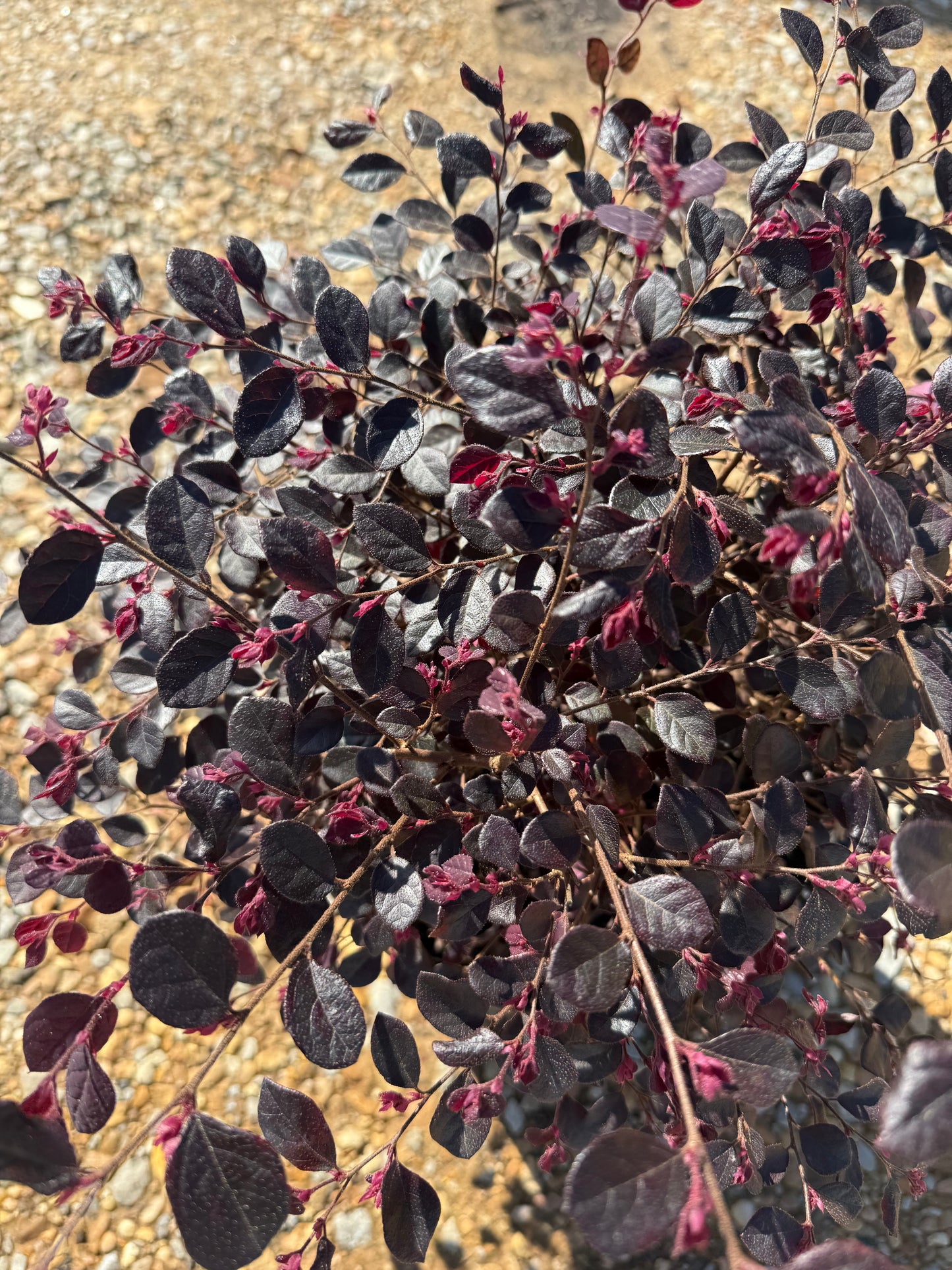Purple Diamond Loropetalum™
Purple Diamond Loropetalum™
2.75 / 5.0
(4) 4 total reviews
Couldn't load pickup availability
![]() Get it between -
Get it between -
zone-7, zone-8, zone-9, and zone-10
Description
Description
If the foliage in your garden looks more like a sea of green than kaleidoscope of colors, then the first addition you should make to your landscape display is adding one, or more, of these stunning Purple Diamond Loropetalum Southern Living™ Plant Collection evergreen shrubs. Growing to a maximum size of 4-5 feet tall and wide when provided regular watering, full to partial sun and well-drained soil, plant your Purple Diamond Loropetalum as an accent color, in a hedge as a mass planting or even in a container for your porch to look its best. Featuring beautiful pink flowers that appear in the Spring and sometimes the Summer, even when the blooms aren’t present the deep purple foliage is beautiful enough to catch your eye all year long. Plant this striking purple shrub in your yard, even if the deer frequent it as often as you do, and this deer-resistant beauty will keep looking lovely.
PP18331
Shipping & Returns
Shipping & Returns
Shipping:
Shipping live plants sometimes has its challenges when dealing with inclement weather but we strive to have every single order shipped out on their scheduled shipping date. Most orders will be scheduled to ship within 1-2 weeks of ordering. Because a plant needs TLC we only ship out on Mondays-Wednesdays to ensure the plants aren’t stationed somewhere over the weekend with no water or sunlight.
When to Ship:
We can ship out plants at anytime of the year pruned or not pruned, cold or not cold. Each plant’s durabilty is different so we recommend having them shipped in their designated season but we will still ship your plant to you earlier if you choose so.
Returns:
Because plants are perishable they cannot be returned without prior permission. We work hard to ensure all plants arrive healthy, but on rare occasions issues with the plant health upon delivery do arise.
Every single shipped plant is healthy upon departing our facility but if a plant is received in poor health contact us immediately so that we can assess the problem and work on saving the plant. We will first need a photo of the plant to start a claim. If we determine your plant cannot be recovered we will send you a replacement immediately. If notified of the plants health within 4 days we will send a replacement 100% free of charge.
If you determine the plant not to be healthy 4 days after delivery you can contact us and we will issue a 50% store credit.
30 days after delivery we cannot be held responsible for the current health of the plant.
Wholesale & Bulk Orders
Wholesale & Bulk Orders
To get started or learn more about our wholesale program and pricing please complete this form.







Questions & Answers
Have a Question?
-
The Texas freeze killed all the leaves but the plant is still alive. It’s very tall like a tree. Do I cut it way back and start over or do I just wait for all the leaves to fall out and grow more?
Prune your Purple Diamond Loropetalum in early spring to encourage new growth. If branches are still alive (green under the bark), trim back lightly to shape. If heavily damaged, cut it back by one-third to rejuvenate. If branches are dead (brittle and brown inside), prune them off completely.
-
How tall and how wide does the Purple Diamond grow?
Grows 4–5 feet tall and wide.
-
Will Loropetalum grow in the dry dessert heat like Las Vegas, Nevada?
No, Purple Diamond Loropetalum struggles in extreme desert heat and dryness.
-
When to prune these plants
Best after flowering, in late spring or early summer.
-
Will it freeze
Yes, it can be damaged below 15°F. Protect in colder zones.
-
Is it harmful to dogs
The Purple Diamond Loropetalum is generally considered non-toxic to dogs. However, it's always a good idea to monitor your pets and prevent them from consuming large quantities of any plant. While Loropetalum isn't known to be harmful, ingestion of plant material can sometimes lead to mild gastrointestinal upset in pets. If you're ever in doubt or notice unusual symptoms, it's best to consult with a veterinarian.
-
I will be planting in my front yard, full sun. I live in El Paso, TX Should I expect this plant to grow well?
Purple Diamond Loropetalum struggles in El Paso’s climate. It prefers humid, mild zones (7-10) and may suffer in the hot, dry conditions of zone 8b-9a without extra water and shade. Consider Texas sage or dwarf yaupon holly as drought-tolerant alternatives.
-
Is it fast growing ?
Moderate to fast-growing under ideal conditions.
-
Does it have a perfume scent?
Light fragrance, but not strong or perfume-like.
-
When is the best time to plant in East Texas?
Spring or fall for best root establishment.
-
Will it grow in southern Michigan? And survive winters ?
Not recommended; it struggles in cold winters.
-
Will this grow in zone 6b
Marginally hardy, may suffer winter damage. Mulch and protect in winter.
-
What are good companions
Azaleas, camellias, hostas, and ornamental grasses.
-
How large can expect it to grow?
4–5 feet tall and wide.
-
When is the best time to plant these
Spring or fall for best results.
-
When should you trim purple diamond lorepetulum
After flowering in late spring or early summer.
-
How tall and wide will it grow?
4–5 feet tall and wide.
-
Can a cutting grow? If so, do I root in water or soil?
Yes, a cutting of Purple Diamond Loropetalum can grow.
Root it in moist soil, not water, for best results.
-
How deep do you plant them?
Plant purple diamond loropetalum at the same depth as it was in its nursery container. Ensure the top of the root ball is level with or slightly above the soil surface to avoid water pooling. Dig a hole twice as wide as the root ball to encourage root spread.
-
What time of year is best for trimin
Late spring to early summer after blooming.
-
Will this plant grow well with little to no water?
Purple Diamond Loropetalum is drought-tolerant once established but still needs occasional watering, especially during prolonged dry periods. It won't thrive with little to no water.
-
May you plant this in August in zone 7?
Yes, but keep well-watered to establish.
-
Is it safe for dogs
Purple Diamond Loropetalums (Loropetalum chinense 'Purple Diamond') are generally considered non-toxic to dogs, making them a dog-safe choice for landscaping. These stunning shrubs with vibrant purple foliage are perfect for adding color to your garden without posing a risk to pets. However, it's always best to monitor your dog around any plants, as excessive ingestion of plant material can sometimes lead to mild digestive issues. Consult with a vet if you notice any unusual behavior after your dog interacts with garden plants.
-
How to prune purple diamond loropetalum.
Pruning Purple Diamond Loropetalum (Loropetalum chinense 'Purple Diamond') helps maintain its shape, encourages healthy growth, and can enhance its blooming. Here's a guide on how to prune it:
When to Prune:
-
After Blooming:
- The best time to prune Purple Diamond Loropetalum is right after it finishes flowering in the spring. Pruning at this time allows the plant to set new buds for the next bloom cycle.
-
Light Pruning:
- Light pruning can be done throughout the growing season to maintain the desired shape or remove any stray branches.
How to Prune:
-
Tools:
- Use sharp, clean pruning shears or loppers for larger branches. Clean tools help prevent the spread of disease.
-
Remove Dead or Damaged Branches:
- Start by removing any dead, damaged, or diseased branches. Cut these branches back to healthy wood, just above a node or at the base of the plant.
-
Shape the Plant:
- To maintain its natural shape, trim back any overly long or unruly branches. Make your cuts just above a leaf node or lateral branch, angling the cut slightly away from the bud.
-
Thinning:
- If the shrub has become too dense, thin it out by removing some of the inner branches. This improves air circulation and light penetration, which can enhance the overall health of the plant.
-
Size Control:
- Purple Diamond Loropetalum can grow quite large if left unchecked. If you need to reduce its size, cut back the branches by up to one-third of their length, making your cuts just above a leaf node.
-
Rejuvenation Pruning:
- If the plant has become overgrown or leggy, you can perform rejuvenation pruning by cutting the entire shrub back by one-third to half its size. This is best done in late winter or early spring, before new growth begins.
Tips for Pruning:
- Avoid Heavy Pruning in Late Summer or Fall: Pruning late in the season can stimulate new growth that may not harden off before winter, leading to damage.
- Monitor Growth: Keep an eye on how the plant responds to pruning. Some Loropetalum varieties grow more vigorously, so you may need to prune more frequently to maintain the desired shape.
By following these steps, your Purple Diamond Loropetalum will stay healthy, well-shaped, and vibrant with beautiful foliage and flowers.
-
-
Would this shrub survive a WI winter?
Purple Diamond Loropetalum (Loropetalum chinense 'Purple Diamond') is not likely to survive a Wisconsin winter. This plant is hardy in USDA Zones 7-10, where winter temperatures are milder and typically do not drop below 0°F (-18°C).
Considerations for Wisconsin Winters:
-
Cold Hardiness:
- Wisconsin generally falls within USDA Zones 3-5, where winter temperatures can drop well below 0°F (-18°C). Purple Diamond Loropetalum is not adapted to withstand such cold temperatures.
-
Winter Protection:
- Even with heavy mulching or other protective measures, Purple Diamond Loropetalum is unlikely to survive the extreme cold and harsh winter conditions typical of Wisconsin.
Alternative Options:
- If you're looking for a shrub with similar characteristics that can survive in Wisconsin, consider plants that are hardy to at least Zone 5, such as Dwarf Korean Lilac (Syringa meyeri 'Palibin') or Barberry (Berberis thunbergii), which can provide colorful foliage and withstand colder temperatures.
In summary, Purple Diamond Loropetalum would not survive a Wisconsin winter and should be grown in a container that can be moved indoors or substituted with a hardier plant.
-
-
How fast do they grow
A Purple Diamond Loropetalum (Loropetalum chinense 'Purple Diamond') is considered a moderate grower, typically growing 1 to 2 feet per year under optimal conditions. This evergreen shrub can reach a mature height of 4 to 6 feet and a similar width within a few years. To ensure healthy, steady growth, plant it in well-draining soil with full sun to partial shade exposure and provide regular watering. With its striking purple foliage and vibrant pink flowers, it’s a popular choice for adding color and texture to the landscape.
-
Does it bloom?
Yes, the Purple Diamond Loropetalum (Loropetalum chinense 'Purple Diamond') produces vibrant pink, fringe-like blooms. These flowers typically appear in spring and may rebloom intermittently throughout the growing season. The contrast between the bright pink flowers and its deep purple foliage makes this shrub a striking addition to any garden. For the best blooms, plant it in full sun to partial shade and ensure the soil is well-draining. Regular watering and proper care will encourage more frequent and abundant flowering.
-
Will this plant do well in Olympia, WA?
Not ideal; too cool and wet for optimal growth.
-
Will it thrive in a semi-shady area in n florida
Yes, it tolerates partial shade, but needs some sun for best color and blooms.
-
Hi would this plant do well in Northwest Arkansas? I'm looking for something similar to the Indian Hawthorne but not Nandina I have some if those.
Yes, Purple Diamond Loropetalum can do well in Northwest Arkansas (Zone 6b-7a), especially if planted in an area with partial to full sun. These shrubs have vibrant purple foliage and pink fringe-like flowers, making them a great alternative to Indian Hawthorne. They are also drought-tolerant once established and can thrive in well-drained soil, offering year-round interest with their evergreen foliage. Just ensure they get sufficient sunlight for optimal color retention.
-
When can you cut it back mine are 5 ft tall and I'd like to cut them back to two and a half foot
The best time to prune Purple Diamond Loropetalum is in late winter or early spring, just before new growth begins. Pruning at this time encourages healthy growth and vibrant blooms. You can cut them back significantly, but avoid cutting more than a third of the plant at a time to reduce stress. If you need to bring them from 5 feet down to 2.5 feet, you might consider a gradual pruning over two seasons.
Tip: After pruning, add a balanced fertilizer to support robust regrowth.
-
How tall when mature
A mature Purple Diamond Loropetalum reaches a height of about 4 to 6 feet, making it a compact, medium-sized shrub that fits well in borders or foundation plantings.
-
What time of the year good for trimmiming
The best time to trim a Purple Diamond Loropetalum is in late winter or early spring, just before new growth begins, to encourage fuller growth and maintain a healthy shape.
-
Will it grow in zone 7 on the east
Yes, the Purple Diamond Loropetalum can grow well in USDA Zone 7 on the East Coast. This hardy evergreen shrub tolerates temperatures as low as 0°F and thrives in full sun to partial shade. In Zone 7, you’ll typically see it maintain its vibrant purple foliage year-round, especially with ample sunlight. For best results, plant it in well-drained, slightly acidic soil, and water it regularly, particularly during dry spells.
-
How much sun does it need? Will it grow in south Florida?
The purple diamond loropetalum likes full sun. It thrives in the southern U.S. inlclduing south florida.
-
What growth zones are recommended
The purple diamond loropetalum thrives in USDA zones 7-10
-
Would this be a hardy choice for a Southern Georgia USA climate...?
Yes, the purple diamond loropetalum thrives in zones 7-10 which inlcudes Georgia
-
I have had to replace these 3 times, and they do not look good at all. The leaves fall off and then die. Could you please tell me why I am having so much trouble with these? They do get sun and partial shade.
Purple Diamond Loropetalums may struggle due to a few common issues: Soil Issues: They prefer well-draining, slightly acidic soil (pH 5.5–6.5). Poor drainage or alkaline soil can cause stress. Overwatering or Underwatering: Too much water leads to root rot, while too little causes leaf drop. Sunlight Stress: While they tolerate sun and partial shade, too much direct afternoon sun in hot climates can scorch leaves. Pests or Diseases: Check for root rot, fungal infections, or pests like spider mites. Transplant Shock: Repeated planting might stress the shrubs if roots were damaged or not properly established.
Solutions:
- Test soil pH and drainage; amend as needed.
- Water consistently, letting the topsoil dry slightly between waterings.
- Provide mulch to retain moisture and protect roots.
- Avoid fertilizing stressed plants, as it can worsen damage.
Consider replacing them with a hardier shrub if conditions remain unsuitable.
-
does the purople diamond leropetatum lose leaves in winter
No, it is evergreen and retains its leaves year-round.
-
Is it salt resistant.
Yes, it is moderately salt-tolerant and suitable for coastal areas.
-
Is it deer proof?
Yes, the purple diamond loropetalum is deer resistant.
-
Will Purple Diamond Loropetalum winter-over in -10 to -15 degree winter weather here in Elkton, MD.? i want to purchase 5 or 6 of them but want to be sure they will survive. I have a nice morning sun area up until 1:30 PM then shade as the sun moves around the garage.
Purple Diamond Loropetalum is hardy in USDA zones 7-10, and Elkton, MD, is generally in zone 7a. While it can tolerate brief cold spells, temperatures consistently between -10 to -15°F could damage or kill it. If such temperatures are common, consider planting in a more protected location or mulching heavily to insulate roots. Morning sun with afternoon shade is an ideal light condition for loropetalum.
-
When do you trim them
Trim in late spring or early summer after flowering.
-
I live in eastern NC. can I plant in grown in the fall months. Does it flower in the spring or summertime.
Yes, you can plant Purple Diamond Loropetalum in the fall in eastern NC; it's a great time for root establishment. It typically flowers in spring and may rebloom lightly in summer.
I didnt get my full order! I ordered 2 plants and you sent one! I've emailed y'all and called y'all more than 6 different times and nobody has contacted me back! The bush received was dead! I want my MONEY NACK NOW ASAP!!!!!!!!
Beautiful bushes. The packaging was wonderful. Nothing was messed up.
It’s a beautiful looking plant a little smaller than I expected for the 3 gallon pot, but it came pretty damaged in shipping. Frankly out of the pot roots loose. I’ve gotten it into the ground and at two weeks still healthy will have to see what happens in the spring.
3 out of 8 plants died on their way here.









